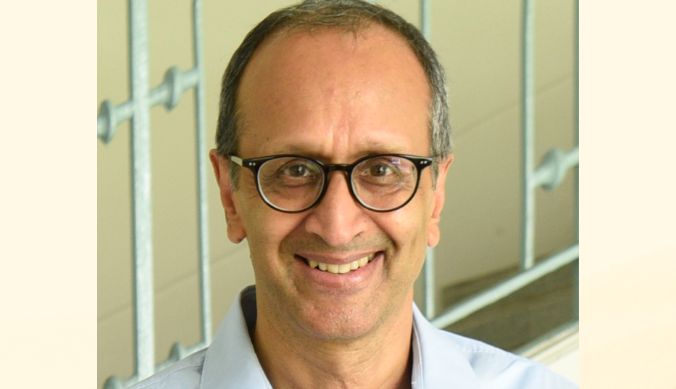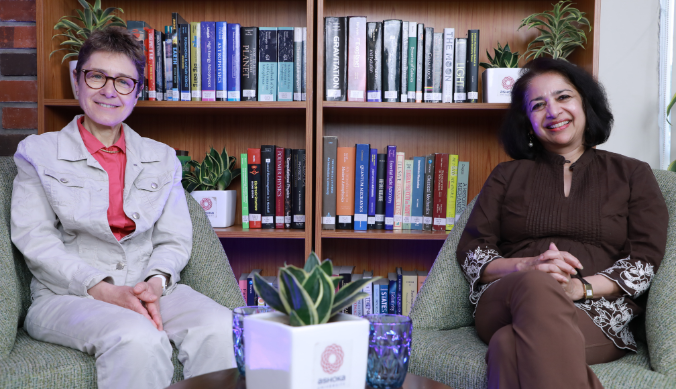“The Natural World Is the Best Book You Can Read”: French Biologist Thomas Lecuit at Ashoka
Professor Thomas Lecuit shares how biology, physics, and mathematics converge to explain the emergence of living forms.
In a captivating session under the Great Ideas Seminar (GIS) 2025 lecture series, Ashoka University hosted Professor Thomas Lecuit, a globally renowned developmental biologist and Professor of Biology at the Collège de France. The event, part of the Lodha Genius Programme’s on-campus engagement, centred on the theme ‘Whence Biological Forms?’, where Professor Lecuit shared how living forms arise through the fascinating convergence of biology, physics, mathematics, and computer science.
Here’s a glimpse of a candid conversation with Thomas Lecuit on his work and journey so far.
What are some of the most surprising discoveries that you have made in understanding how complex organisations are formed?
Thomas: One of the important findings that we had in the past in my group was an understanding of how massive tissue-level reorganisation, such as the extension of the body axis of the embryo, occurs. And so, by careful analysis of the cell trajectories under the microscope, we came up with a very simplistic, generic model. What we found was that the dynamics, the flow of cells as if it were a fluid, emerges from a pattern of contractility. And it was surprising that the fluidity of the tissue emerged from something that provides tension in the tissue. Because typically, when we think of tension, we associate it with formation, like in bending, where it produces elastic or contractile tension. But in that particular case, it conveyed fluidity, fluid behaviour over long time scales. That emphasised the importance of the concept of surface tension as a generic physical way of understanding cell organisation, dynamics, and fluid behaviours. It offered a way to encapsulate many different processes under the same physical principles. So, this has been an important finding. And it also opened new doors in thinking about how such contractility could be spatially organised. Depending on the tissue, contractility would be organised one way or another. And so, it opened a direction to think about how such mechanics are spatially and temporally controlled.
Why do you use a fruit fly to understand how living forms take shape?
Thomas: We’re interested in morphogenesis, that is, understanding how a group of cells gives rise to an organism or a specific organ, like a kidney, heart, nose, or even the nervous system. To study this, we need an experimental system that can be both observed and perturbed easily. This is where the simplicity and practicality of model organisms come into play. The fruit fly is one such model organism. It’s relatively simple, reproduces quickly, and is inexpensive to raise in the lab, all of which make it ideal for biological research.
The use of the fruit fly dates back to the early 20th century, when TH Morgan discovered that these fast-developing animals, with only a few chromosomes, could be used to study the relationship between morphological traits and structures on the chromosomes, which could even be visualised under a microscope. This work laid the foundation for genetics and the study of model organisms. Over the decades, other organisms like the nematode were introduced because of their simplicity; they have fewer cells, and scientists could track every single cell under a microscope. These systems have been instrumental in major discoveries in life sciences.
Model organisms, like the fruit fly, offer simplicity and suitability for modelling, which helps us make sense of complex biological processes. Today, there are many model organisms used in research, but I still love the fruit fly because of the rich variety of problems you can explore using it, especially given the powerful tools we now have for quantitative analysis and perturbation.
Can you explain how mathematics, physics, chemistry, and biology all come together in giving rise to biological forms?
Thomas: Traditionally, biology was seen as the sole discipline to explain living systems. But that view has shifted significantly. Biology today is essentially an effort to understand life, and this requires input from many disciplines. In the 20th century, we began to uncover the chemical foundations of life. At the start of that century, people didn’t even know what the core constituents of life were. Gradually, scientists discovered that the genome is made of nucleotides, that proteins exist, and they began to understand the basic chemical components and how they interact to build cells and organisms.
But in the 21st century, the challenge is different. We’re now trying to understand how, from these basic chemical constituents, complex systems emerge, like a single cell becoming a functional unit capable of performing tasks and interacting with its environment, whether it’s a bacterium or a human cell. The task now is to understand the complexity of living systems. How do simple interactions, among molecules inside a cell or among many cells in an organism, give rise to emergent properties? For example, how does an embryo develop from a fertilised egg? Or how do groups of molecules form a functioning cell that divides and communicates with its environment?
To tackle this complexity, we need contributions from multiple disciplines:
Phenomenology- the observation and analysis of processes, which requires experimental sciences like biology and physics.
Data Analysis- involving statistical methods and machine learning from computer science and applied mathematics, to handle complex datasets.
Modelling- framing our understanding in mathematical terms. This includes identifying key parameters and rules of interaction that can be captured by governing equations describing system evolution.
So, modern biology is a deeply interdisciplinary field. We need biology and chemistry to study molecular and cellular phenomena, and we rely on physics, mathematics, and computer science for analysis, data interpretation, and theoretical modelling.
What is one exciting or underexplored area in biology that you think could lead to major breakthroughs in medicine and biotechnology?
Thomas: I think there are quite a number of important problems that we don’t understand much about. One area I find particularly fascinating is the question of what defines the size of an organism. We humans, for instance, are very symmetric; there’s exquisite control over the size of structures and proportions among different organs. But what sets the lengths of these different structures to produce a particular morphology is something we still don’t understand well, despite years of research.
One direction we’re currently exploring in the lab, after having studied the roles of chemical signals and mechanical signals in setting up length scales, is the energetics of the system. How much energy is consumed and harnessed in cells to actually fuel growth? Could energy availability become a limiting factor? Could energy limitations be part of the mechanism that controls the size of a structure? There are also related questions like: Why are some cells big and others small? How do cells scale their internal structures to match their size? How does a cell “know” how much to produce internally as it grows? Where do these internal proportion rules come from? Could there be such a thing as a universal cell model, a framework to look at cells in terms of their proportions that might apply across types?
We’re interested in these questions, and we study them through various cell types, including neurons. So, in short, the questions of size, scaling, and proportion in the context of cells and development are fascinating and still poorly understood. I believe that answering them will require a multidimensional approach, integrating chemical information, signalling, mechanics, and perhaps most intriguingly, energetics.
What role do you think institutions like Ashoka University and the Lodha Genius Programme can play in fostering the next generation of researchers?
Thomas: I think it’s very important that students explore the breadth of different corners of knowledge. They should be exposed to the richness of science, but also not be siloed within a single discipline. Of course, you have to be good at your subject, but it’s clear that the great challenges facing our society, whether in medicine, biology, climate, or ecosystems, require many disciplines to work together.
This is where the liberal arts training at Ashoka becomes especially important. Even if you go on to become a scientist, I believe it’s essential to have a solid understanding of culture, society, history, and literature. That’s something I strongly believe in. When I teach my courses at the Collège de France, I always go back to the history and philosophy of science, I think that’s very important.
The second point is that while we learn a lot from classes, it’s also essential to be educated to think independently, and to be exposed to scientists and the process of inquiry. This is something I see clearly in the Lodha Genius Program. When I observe high school students working together with undergraduate TAs and professors, all engaged in practicals and discussions, I see a lot of energy, enthusiasm, and passion. And I think that’s truly great.
Is there a book that you often recommend to students who are curious about how the natural world works?
Thomas: I think the best book about the natural world is the natural world itself. Go out, look at ecosystems, and develop your sense of observation. In fact, Galileo spoke of the “book of nature”, the universe itself, as a source of inspiration. So I always say: make your own observations. That’s the best starting point.
That said, there are a few books I find especially meaningful. One that I often recommend is a small but powerful piece by Abraham Flexner, the founder of the Institute for Advanced Study in Princeton, titled The Usefulness of Useless Knowledge. The title says it all: it’s a manifesto in favour of intellectual freedom and exploration, arguing that some of the most impactful developments in society arise from curiosity-driven research.
Another book I really enjoyed recently is The Invention of Nature, a biography of Alexander von Humboldt. He was a true polymath of the 18th and early 19th centuries, a universalist who travelled the world studying geology, physics, and ecosystems. Humboldt was the first to identify patterns across diverse landscapes, showing how nature could be understood through unified principles, an idea I often share with students. He also documented the impact of human activity on ecosystems more than 200 years ago, making his work incredibly timely today.
And if you’re more interested in biology or science more broadly, I’d recommend What Is Life? by Erwin Schrödinger. It’s a classic, not just in content, but in style. It’s a wonderful way to reflect on the foundations of biology through the lens of physics, and a great educational read for students and curious minds of any age.
Study at Ashoka












